20. Conservation as an Enhancing Factor in the Interpretation of Living Materials Artworks
- Flavia Parisi
- Maura Favero
- Rosario Llamas Pacheco
author-date references that should be added to the biblio for this page, although never cited: Corzo 1999 Llamas-Pacheco 2018 Pietromarchi 2017 Subrizi 2012 Zevi 2005
Conservation issues are usually key to a comprehensive understanding of an artwork, and foster dialogue between art historians and those physically working with artworks such as curators and collectors. If the art history approach tends to focus on the past context and life of the artwork, providing an essential background for its interpretation, conservation expands this perspective to its present and future life, offering a deep framework for specific interpretive readings. By questioning what is valued and what needs to be preserved, conservation investigates some of the most relevant and distinctive aspects of an artwork.
The display of contemporary artworks made with living materials highlights the strong interdependence of practical and interpretive issues, which must be addressed through an integration of conservation and art historical approaches. The importance of such materials, food in particular, can be overlooked if interpreted only for what they immediately represent and not for their function in the specific context of the artwork. As artistic materials, their color, shape and texture are relevant.
Public institutions and private art galleries often constitute the channels through which an artwork and its significance are made accessible to a broader audience. Their understanding of the multiple layers of interpretation of the artwork’s material and symbolic values as intended by the artist, and of the layers of meanings related to the work’s historical and artistic context, is essential to accompany the work through its journey into society.
In the case study presented here, the fact that no conservators were directly involved in the display of the work in question, especially given the very specific nature of the materials and composition, meant that it was not fully understood by those taking care of exhibiting it, and skewed the way it was presented to the public. Precipitazioni Sparse (Scattered Precipitations, 2005) is a work of art by the Italian artist Bruna Esposito (b. 1960) composed of white, golden, and red onion peels placed randomly on a marble slab. There is no additional material applied to secure the peels to the marble. The artist calls this work an “impermanent sculpture,” since the onion peels can shift with the slightest air movements, creating continuous changes in the work’s composition.1 Onions are a familiar cooking ingredient in most regions of the world. Marble is a strong and noble material that evokes classical aesthetics. So if onions are an ordinary material of daily life, in this composition, they are elevated into an artistic material thanks to the marble, another traditional artistic material.
Precipitazioni Sparse has been exhibited only twice, and the way it was presented on both occasions offers an opportunity to consider the interrelations between various assumptions and interpretations of the work and its documentation. In order to explore these issues, our research included analysis of archival documents and interviews with the artist, the two collectors owning the artwork, an art dealer who has worked with the artist for many years, and a museum director who is particularly familiar with Esposito’s research and has curated several shows of her work.
Background
Esposito is well known for her multimedia and sensory works that engage sound, sight, smell, and more. Her artistic practice includes sculptures, videos, installations, performances, site-specific projects, drawings, photographs, and collages. Her works are often made with simple, ordinary materials and techniques, which are ennobled by poetic associations. Her collaborations with artists, poets, and musicians have produced work that blends these various disciplines, defying classification.
Precipitazioni Sparse was specifically commissioned for the Venice Biennale in 2005 (). The artist realized the project on site. She ordered the marble slab from Carrara and organized its delivery to Venice, where it was mounted to a wooden grid in order to keep it perfectly aligned and stable on Arsenale’s irregular ground. Esposito then meticulously selected the onion peels and personally dispersed them on the marble in an apparently accidental composition that harmoniously covered the entire surface area.
The project was subsequently purchased by two Italian collectors who have been patrons of Esposito for many years and were immediately seduced by its beauty. The same collectors, who are also the directors of a private foundation dedicated to the promotion of contemporary artists, decided to reproduce and exhibit the work in 2011 on the occasion of a local art fair in Rome, titled Road to Contemporary Art. At the moment the work is only accessible through photographic images, which are easily found online and represent the work in the two exhibitions, and even a casual observation of these photographs reveals differences. In the image published by the Archivio Storico delle Arti Contemporanee (ASAC, or Historical Archives of the Venice Biennale) the onion peels are all concentrated at the center of the marble slab in a way that does not correspond to the picture taken when the artwork was realized (compare fig. 20.1, fig. 20.2).2 And in photographs taken during the art fair in Rome, the color tone of the marble slab looks very different from its appearance in Venice, and the work looks cramped in the stand, with not much room for the air movements the artist intended (fig. 20.3).
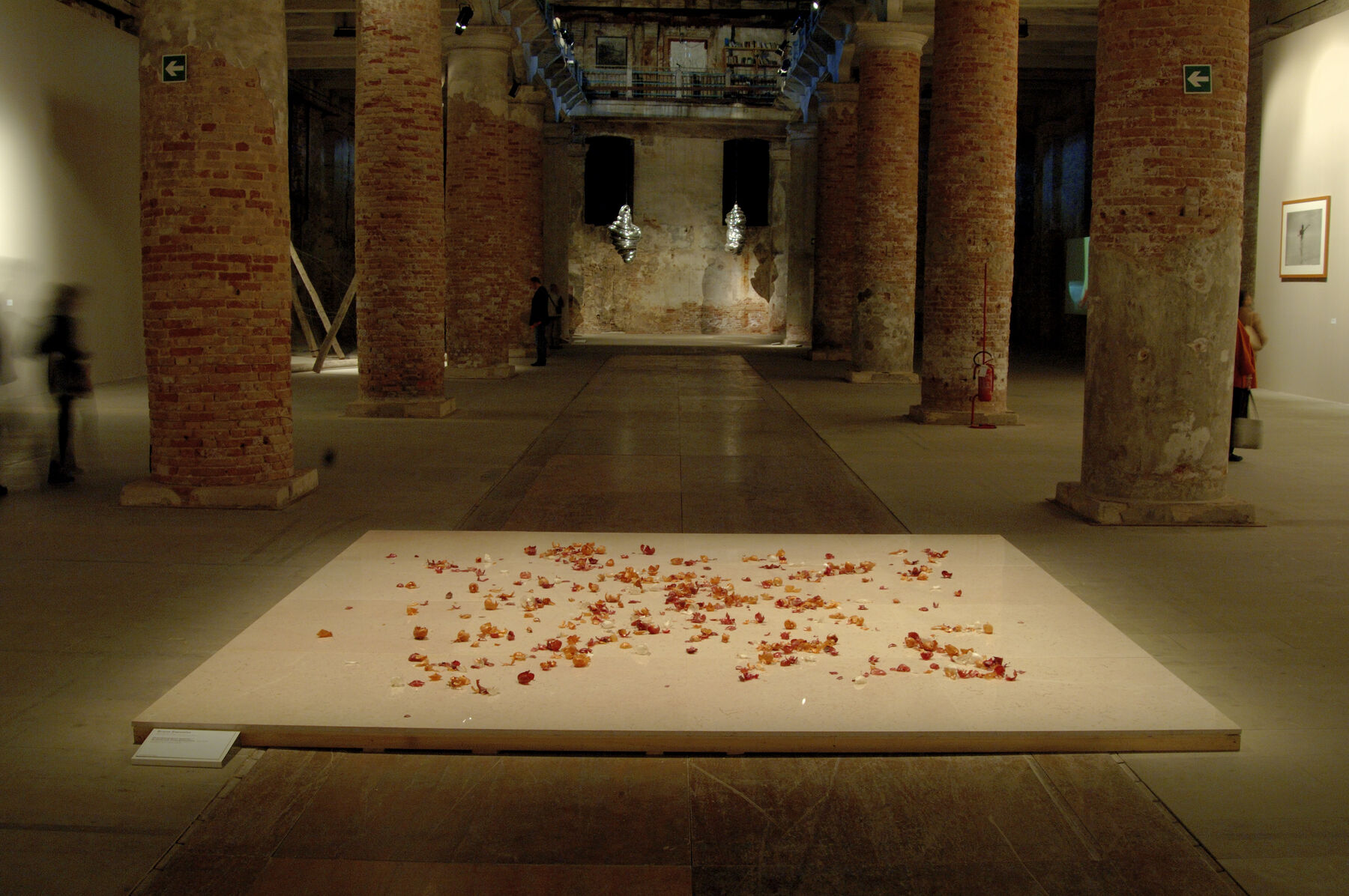
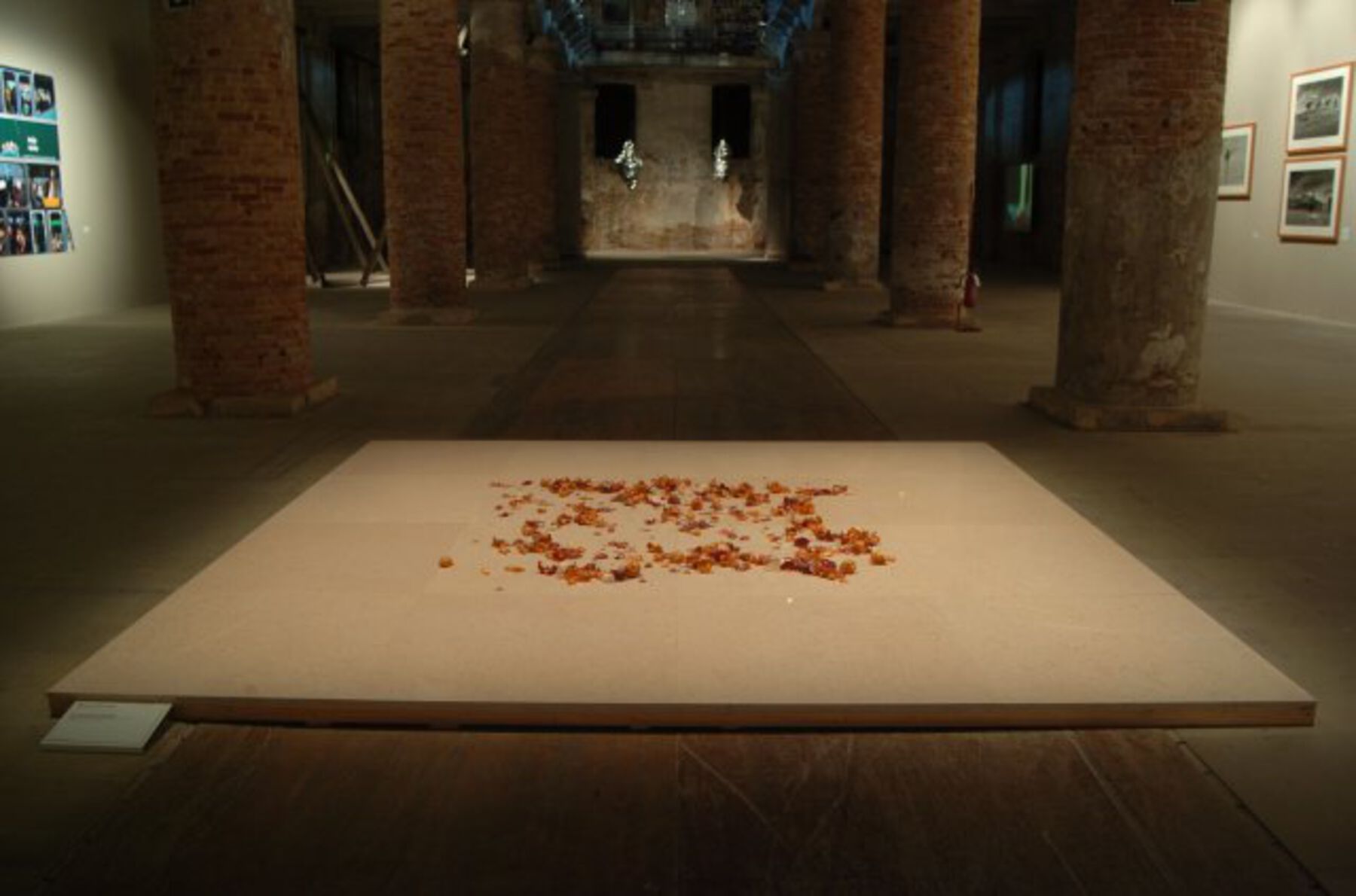
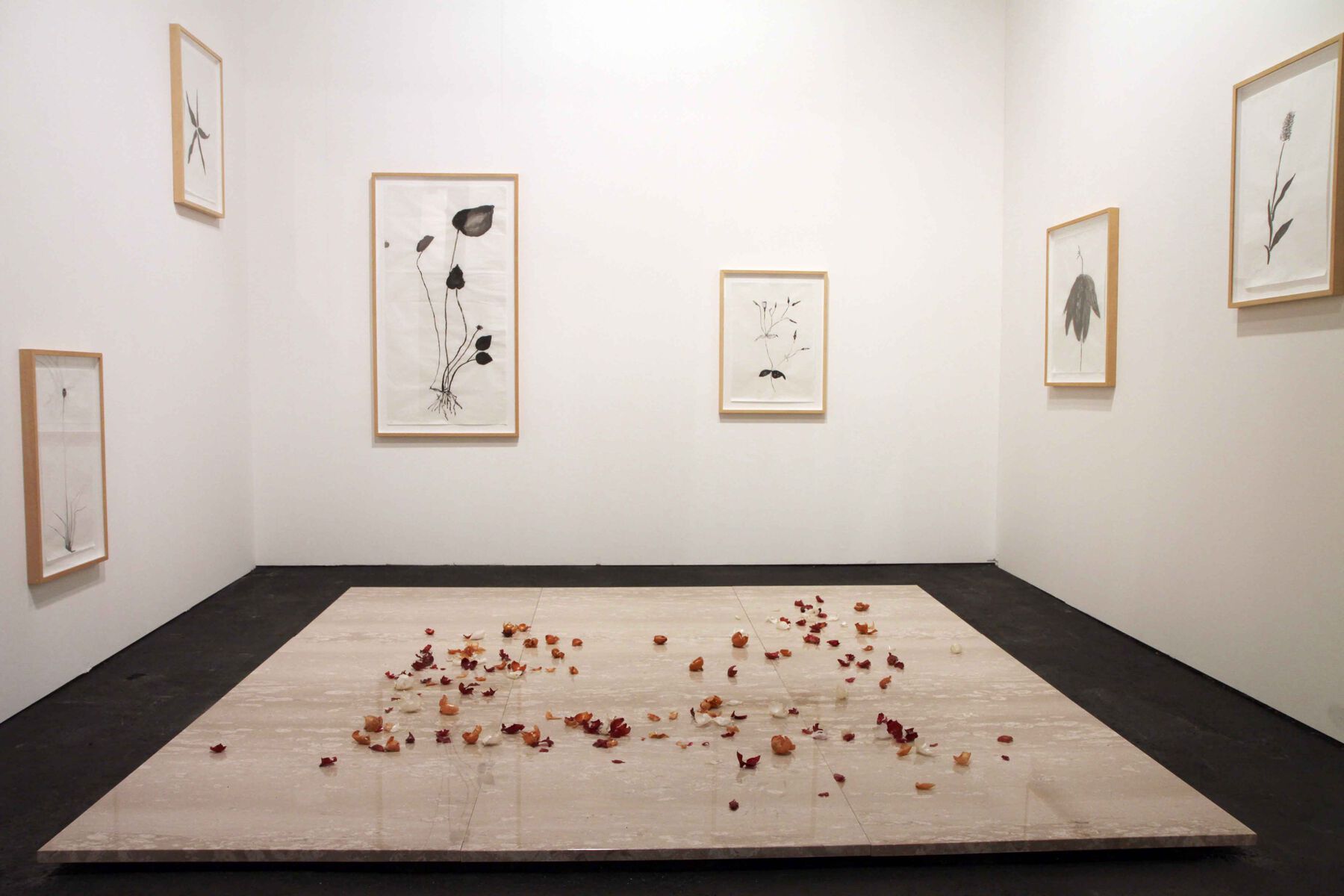
Looking at these photographs elicits some obvious questions: Why are there differences across the pictures? Did the onion peels and marble slab remain the same from one exhibition to another? How else has the artwork been documented?
Unpacking Preconceived Ideas
The first findings resulting from our research were the many preconceived ideas everyone involved had, including the authors of this paper. Before interviewing the owners of the work, the authors had assumed that, after dismantling the work, a most likely difficult decision had been faced regarding what to do with the onion peels, and that the collectors had kept the marble. On the contrary: during the interview, the authors found that the issue of retaining the original materials chosen by the artist was easy to resolve for the collectors, who in the end didn’t keep anything from the original installation. For them, the beauty and value of the work lay in the harmonic contrast between onion peels and marble—not in these specific peels or stone (for instance marble tone, color, and veins, or the colors and shapes of the selected onion peels). The collectors were eager to discuss art and poetry in general, separating that discourse from any specific artistic designation of the materials themselves.
At first sight, especially for those who are not directly involved in conservation issues, the work seems quite simple, being composed only of two elements. For the owners of Precipitazioni Sparse, the incredible poetry of the work resides in its immediateness and simplicity. Over the course of the interview, many of our conservation-related questions were interpreted as obvious, for instance: “We do not have the fetishism. . . . It is obvious that after a while you have to throw the onions away and buy new ones. We do not have such type of obsession with the artwork, because we are used to working with art, and we know very well the oeuvre of the artists we work with.”3 In their view, having worked closely with an artist in the past somehow guarantees an understanding of their artistic intent in all cases. If they reported an urgency to enter into, in their words, “the spirit of the artist” in order to relay it to an audience, the so-called spirit lies, in their eyes, largely in the overall concept and not much in the specificity of the materials, nor, importantly, in the particular characteristics of the space and lighting conditions in which the work is assembled and exhibited.
The collectors’ decision to not preserve the onion peels was approved by the artist, who confirmed this in a recent interview with the authors. But a subsequent reinstallation took liberties she would not have approved of. Six years after Venice, on the occasion of the 2011 Rome art fair, the artist unfortunately could not participate in the installation and the owners made some decisions independently. During our interview, Esposito mentioned that she did not approve of the marble used in the second exhibition, which was “too pink” and “too veined”—too different from the marble chosen for Venice (fig. 20.4). Apparently, she only became aware of the importance of this aspect after realizing that the two collectors exhibited the work using that type of pink marble. Had she been consulted, she would have provided more opinions regarding other aspects of the work as well. For instance, in the Rome exhibition the neon lights above affected the perception of the work, whereas now a pointed but gentle light that produces no reflections on the marble is recommended by the artist.
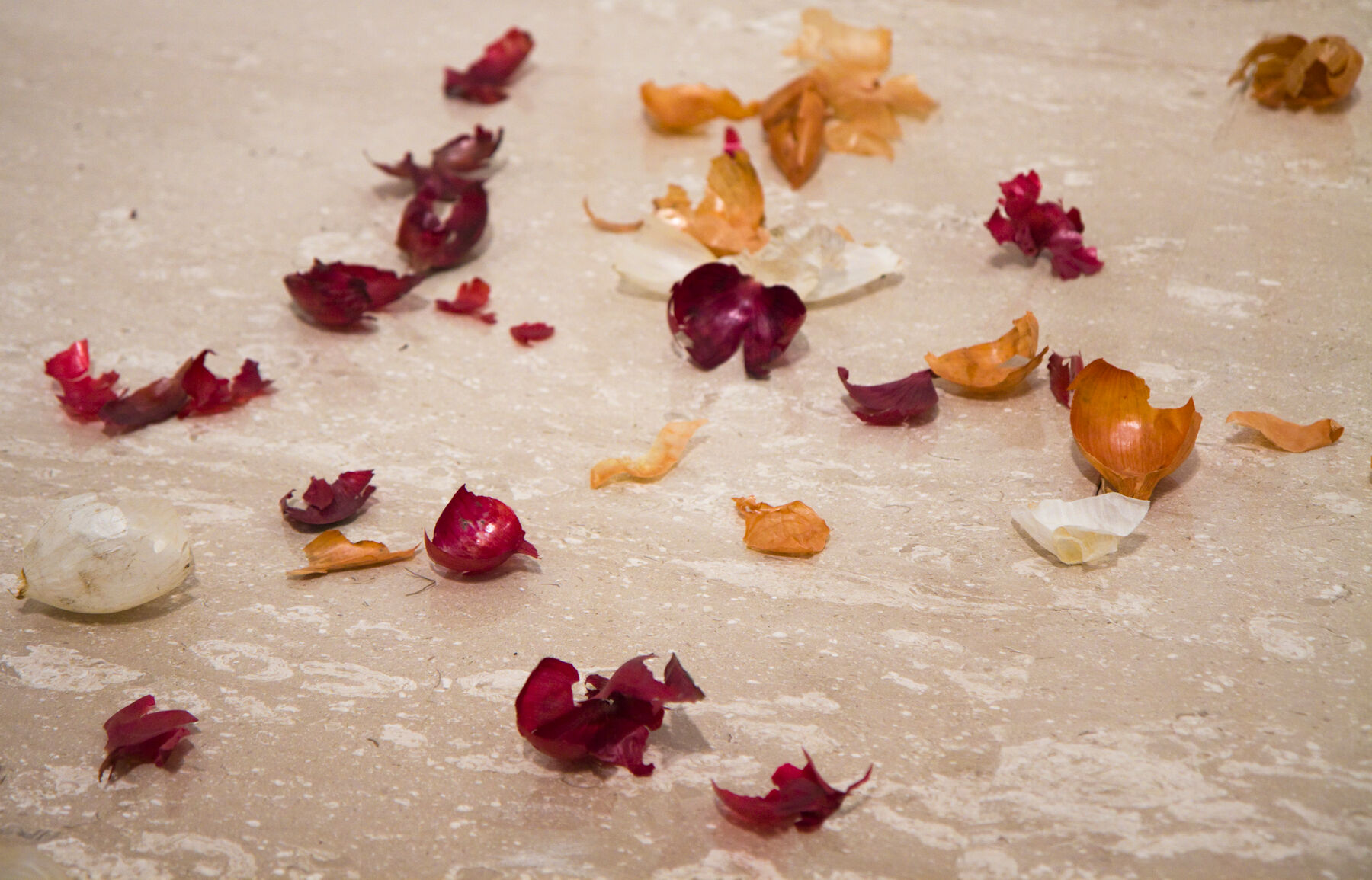
Other problems in presenting the work arose from misunderstandings on the part of the staff in Venice involved with maintaining it. In one instance, Esposito recalled friends who had seen the show telling her how much they appreciated the “flower petals.” She could not understand how that confusion came about until she saw the picture published on the ASAC website (see fig. 20.2). During the Biennale, dust accumulation was greatly affecting the aesthetic of the work, so she suggested that maintenance staff periodically remove the onion peels, clear the dust, and then reposition the peels on the marble; unfortunately, the staff repositioned the peels carefully at the center of the platform, not scattered as before. The marble platform was quite big—four by four meters—which put the centered peels quite far from the eyes of visitors, who, in the dark atmosphere of the Arsenale, could not see them properly and mistook them for flower petals.
Assumptions—by all parties involved—have a strong impact on the way artworks are exhibited and understood, and rely on the conviction that the available information and its subsequent interpretation is enough. It is almost impossible to completely avoid assumptions, especially when dealing with installation, performance, and other nontraditional forms of art. But awareness of the tendency can help stimulate both the artist and those working with them to keep questioning the specificities of the work and its context.
Documentation
Documentation played a crucial role in our research for this paper, as it had the potential to connect practical and interpretive issues. Preliminary research related to the work’s exhibition history revealed the different ways it had been presented and interpreted, but did not immediately explain the reasoning behind these differences. So we sought out further information.
Among the first documents analyzed was one provided by ASAC, after they were contacted as to why their website published a photograph representing the work in a condition so different from the original installation. They provided a document, written and signed by the artist at the moment of creating the work, that included the work’s description and recommendations related to its maintenance during the exhibition. Although the artist’s phrasing was ambiguous, it does not appear that the Biennale contacted her for clarifications regarding what she meant by “ricollocare le bucce al centro e ben sparse” (position the peels at the center and well dispersed).4 The instructions were interpreted literally, without questioning the difference in appearance before and after the dusting treatment.
The fragility of the onion peels, further complicated by the potential interactivity with the surrounding context, was not considered by any of the actors involved in the staging of the work. Their condition was not documented, and the numerous directives by the artist in the data sheet made after creating the work were not further clarified (these included the minor movements of the onion peels on the marble; the eventual need to replace some of the peels during the exhibition; and the visitors’ potential interaction with the peels). Developing thorough documentation of an installation determines not only the accuracy of future installations, but also their accessibility. The information provided by diverse types of documents such as data sheets and photographs is certainly beneficial to specialists and researchers, but in some cases it can be as well to the general public. This is the case with archival material made accessible through websites such as ASAC’s.
The case of Precipitazioni Sparse now challenges both the artist and ASAC from its two iterations. The artist does not recognize the ten images at ASAC’s website as authentic representations of her work, and so she has proposed taking them down; in her view they are inaccurate documents. ASAC, for its part, seems disinclined to eliminate or modify a document that has undergone an archival process, which renders it in their mind official and definitive. If imagery provided by the artist is not made available, collective memory of the work will remain inaccurate—as confused as the idea that the onion peels were flower petals. This demonstrates quite powerfully how documentation related to contemporary artworks is crucial but cannot necessarily be relied upon. It is a tool needed to preserve the artist’s intention and the artwork’s memory, but also to provoke questions about its future.
Interpretation
An insightful curator has compared Esposito’s works to “poetic compositions, where power and lightness continually encounter each other in an apparently fragile balance, capable, however, of opening up profound spaces of reflection.”5 If the artist regards her materials as like words in a poem (, 6), how each material is interpreted by different stakeholders becomes particularly significant. The parallel with poetry might be especially useful if one equates installation with translation, and how both constitute an interpretation. Let us consider, for example, the translations of Wisława Szymborska’s poem “The Onion,” from the 1976 book A Large Number, from Polish into English and Spanish. The poem can be understood at its most basic level in other languages, but whether the reader can appreciate the nuance of each word, its sound and the image it conjures, depends completely on the careful work of the translators. Translators are the vehicles through which the poem can reach a broader audience. Their work involves a deep thinking behind each word, and the balance of literal and free interpretive choices. Their role has such a strong impact on the text’s interpretation that their name is always reported.
In the two versions of Precipitazioni Sparse not approved by the artist, the literal execution of the work was followed, but the effect created by the composition was quite different from what she had planned. As words and their sound matter in poetry, so do material specificity and the exhibition context in art. The particular value attributed to the materials is far more a priority for Federico Luger, a dealer who holds Sereno Variabile (2000), a series of Esposito’s works made with onion peels (). During our interview with him, he mentioned the enthusiastic feedback on the work from visitors at numerous art fairs, and the symbolic meanings he attributed to this material: “The onion, one of the poorest and cheaper aliments, it is the only food that makes you cry when you open it. You can easily imagine that there was something before the onion peels: someone who cried. . . . A situation that can be changed by the moving possibility of the composition.”6
In our recent interview with the artist, we asked about her criteria for selecting the materials for Precipitazioni Sparse, in particular the types of onions she chose. She replied that the choice was easy and based on three types of colors. We then showed her a basket containing many different onion types. Confronted with the variety of choices, and the possibility to manipulate the material over the course of the interview, the artist realized that her criteria were more articulated in her mind than what she had initially stated. She finally verbalized her thoughts, and explained in detail all the aesthetic qualities she seeks in the onion peels (fig. 20.5, fig. 20.6). For instance the driest, most external, thin and rounded skins are used, including small pieces, and any peels with mold on them are discarded. She does not want any signs of degradation to be visible (including dust on either the marble or the onions), since this would add a dramatic component that would distract from the beauty of the composition. Tthe artist shared her enthusiasm for the infinite play of colors, shapes, and combinations that one can find in onions: “One day I saw the onion. I saw them like I have never seen them before. I decided to work with them. They are so beautiful. Can’t you see how much they are beautiful? With my work I wish to make visible something that is usually difficult to see. It is all about looking. We do not know how to look at things.”
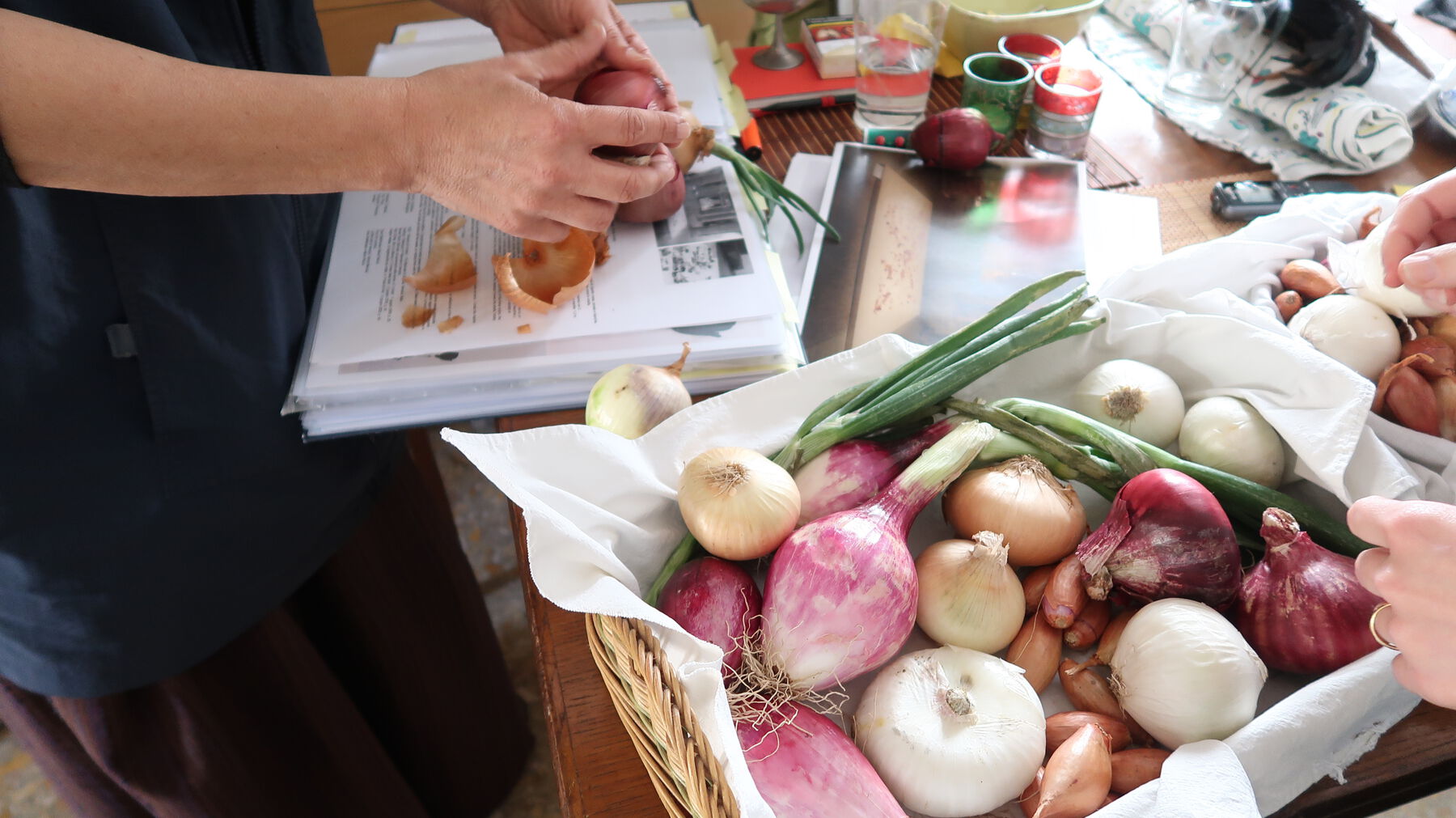
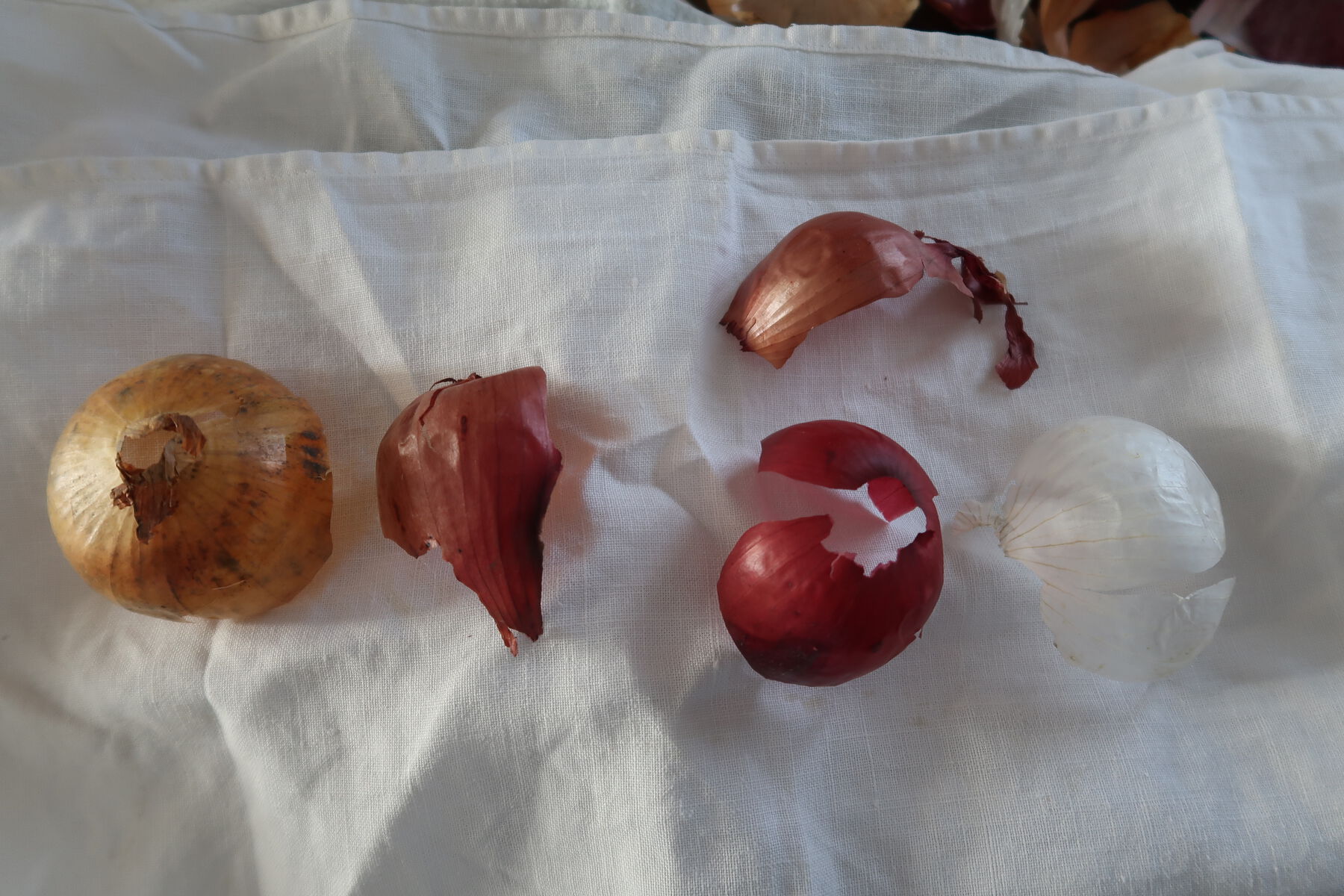
While sorting through the onions, the artist also made an impromptu demonstration of how to disperse them on the marble, which we recorded on video (fig. 20.7). This offers the intriguing opportunity to reflect on the gestures of dispersal she likely used for the initial installation in Venice (fig. 20.8). Bartolomeo Pietromarchi, director and curator of the MAXXI Museum, who has collaborated with Esposito on various occasions, noted how these gestures are very much related to some of her other works involving performance, even though Precipitazioni Sparse itself does not have a performative element.7
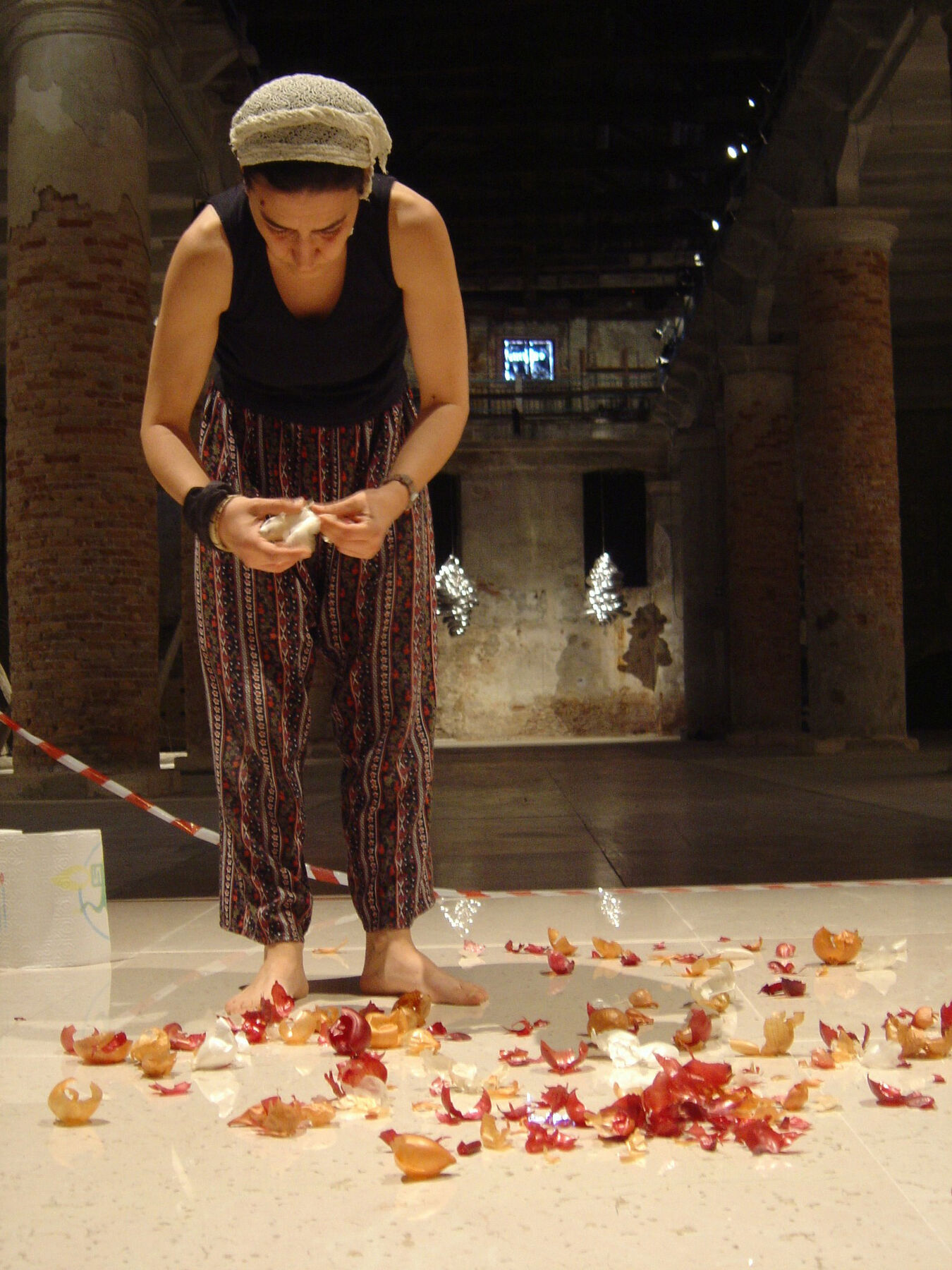
Conclusion
Those exhibiting contemporary artworks, whether in the public or the private sector, have a responsibility to transmit the values embedded into the works’ materials and history to audiences. This should be guided by a deep understanding of the work, its production, its context, and how it will likely be perceived by those experiencing it. The artist’s intention is crucial to an understanding of the work, but it needs to be investigated and questioned, along with its surrounding context. The meanings to which the artist in this case assigned the most importance depended on material appearance. This can create interpretive challenges for those who intend to reinstall the work. How important is it for the artist that the actual material be preserved from one exhibition to another? What is her specific opinion about each onion peel and its position on the marble? Or about the marble color tone? These characteristics are not always easy to interpret, or replicate; in this case most of the artist’s choices crystallized in the moment of creating, or when rethinking about the work, but not when she was preparing instructions for its maintenance while on view.
Selection of materials and display choices are therefore the most challenging aspects concerning the installation of Precipitazioni Sparse. Studying the different ways in which the work was previously presented and the reactions of the artist toward these situations has shed new light on her criteria. Furthermore, sharing conservation concerns with different stakeholders can help them formulate more precise questions related to the work, and facilitate the emergence of new ways of interpreting it. The specificity of the materials with which the artist works is the starting point to fascinate audiences with an artwork’s potential to transform something prosaic, like an onion, into a poem.
Acknowledgments
The authors wish to thank Bruna Esposito, Federico Luger, Sara Petracca, Mario and Dora Pieroni, Bartolomeo Pietromarchi, and Yamina Tavani.
Notes
Unless otherwise noted, comments of this nature about the intent behind the work mostly derive from our author interview with Bruna Esposito, May 22, 2019. ↩︎
The ASAC web page in question is http://asac.labiennale.org/it/documenti/fototeca/ava-ricerca.php?scheda=97513&p=1. ↩︎
Author interview with Mario and Dora Pieroni, April 26, 2019. ↩︎
From the data sheet signed by the artist and conserved by ASAC: Fondo_storico_arti_visive_b_840_4_ Bruna Esposito_Precipitazioni Sparse. ↩︎
Marcella Beccaria, curator’s comments written on the occasion of the artist’s show at Castello di Rivoli, Turin, Italy, 2002, https://www.castellodirivoli.org/en/mostra/bruna-esposito/. ↩︎
Author interview with Federico Luger, May 22, 2019. ↩︎
Author interview with Bartolomeo Pietromarchi, July 16, 2019. ↩︎
Bibliography
- Beccaria 2002
- Beccaria, Marcella, ed. 2002. Bruna Esposito. Milan: Charta.
- Esposito 2001
- Esposito, Bruna. 2001. “Sereno-variabile.” Cahiers intempestifs, no. 13 (October–December): 32–35.
- Martinez and de Corral 2005
- Martinez, Rosa, and Maria de Corral, eds. 2005. La Biennale di Venezia. 51a International art exhibition. Always a Little Further. Venice: Marsilio – Fondazione La Biennale di Venezia.